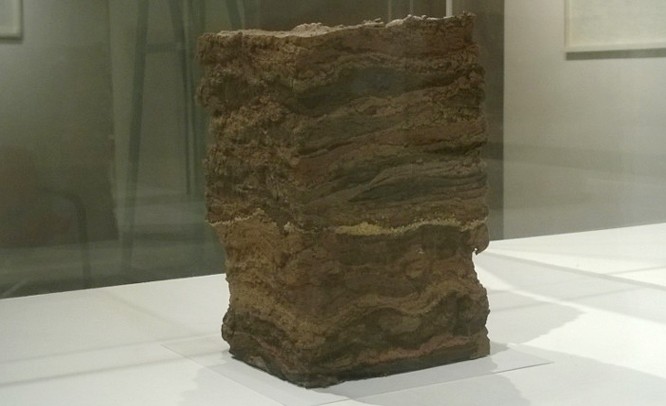
At an exhibition being held at Rohtas 2, Lahore, Farrukh Adnan transforms his hometown Tulamba into a poetic entity

You encounter usual stuff at the table before entering the gallery. Along with exhibit lists and bowls of potato crisps and cookies is a plate with a chocolate cake. The cake emerges again in another form: three cakes of clay are cut and placed inside transparent boxes inside the display space. Composed with layers of soil of different consistency, colour and sites, these look like geological sections with varying levels, but are actually miniature models, not bigger than 7 inches from any side, of what could be a depth of several metres.
These are works from the solo exhibition of Farrukh Adnan, each called ‘Excavation’ (I, II, and, III) being held at Rohtas 2, Lahore from November 18-December 1, 2018. They remind one of Ayesha Zulfiqar’s sculpture ‘Slice’ at her degree show at NCA in 2008. These also hark back to Adnan’s long obsession with his place of origin, Tulamba, a small settlement in Southern Punjab, which according to the artist has a history that can be traced back to 2nd Century BC. It has a fort and is believed to be a trade centre in ancient times.
It is uncommon for an artist to be so fixated with his hometown. Even though he does not live there, the work is heavily dependent upon it. In contrast to artists who are comfortable rendering scenes of their surroundings, Adnan approaches location in another manner. Unlike a voyeur or a tourist who glances and records his observations in a city, maybe through a camera, Adnan concentrates on ‘reality’ more like a mathematician or a mapmaker. The fact that soil was collected and then composed (could be from any location in Punjab) introduces an element of truth to it.
One may or may not believe in the soil’s connection with Tulamba but one cannot avoid the existence of a raw substance that is presented as art. The shift from soil (matter) to soul (art) is a remarkable feat in terms of his ideas. Tulamba has a more subjective significance for him. As for the viewers, the three ‘Excavations’ could be from anywhere in the region.
The exhibition includes 15 works on paper or canvas. These pieces look like exercises in cartography but not in a conventional format. According to British author Simon Garfield, maps originally "began as a challenge of the imagination and they still perform that role". Thus Adnan opts for a personal portrayal of his city and, in the process, transforms it into a poetic entity. For instance, in ‘Manifestation’, a google map of Tulamba is printed on a sheet, is added with texture, further stained and wiped. Outlines of houses are drawn in black, but the print suggests a landscape of some other territory, perhaps not of this planet -- or a blend of physicality and perception. More like a mirage of memory since in our recollection actual places and objects survive in a simplified and superimposed scheme.
The aspect of memory is important to access Adnan’s creations. In his work from MA Degree Show 2014 at BNU, and from his solo show ‘Unfolding Matters’ at Sanat Initiative in 2015, the artist had drawn lines and marks that denoted his visits to and within his hometown. These visuals were like mind-maps of an act that was private and passionate, yet ordinary because many may be travelling to Tulamba every hour of the day, or to several other destinations. It is only how you transform that journey into something profound that determines the lasting worth of that experience. In Adnan’s work, one witnesses that tendency to transcend the ground and communicate a wonderful and broader encounter.
This encounter -- the accumulation of dots, dashes, lines occupying the whole surface (in two series: ‘Beyond Time’ and ‘History in the Making’) -- invites a viewer to identify, discover and decipher each mark. In a way, the viewer also moves not with the maker but inside the work, while spending time in front of the piece. These intricate and complex marks, in their variation of scale, nature, and tone resemble some ancient script. The viewer is forced to ‘read’ these shapes which echo the format of alphabets without a link to any known language.
Trying in vain to justify these surfaces, Adnan states the jottings were inspired from inscriptions on pottery pieces from that particular site. But one feels this attempt in legitimising his imagery is a compromise, an easy solution. These artworks exist as strong visuals -- reminding one of canvases of American painter Mark Tobey. The artist’s efforts in providing clues and contextualising his imagery do not succeed.
His other works that deal with the transient aspect of experience seem to have a lasting effect, just the way the soil is permanent and soul is eternal.